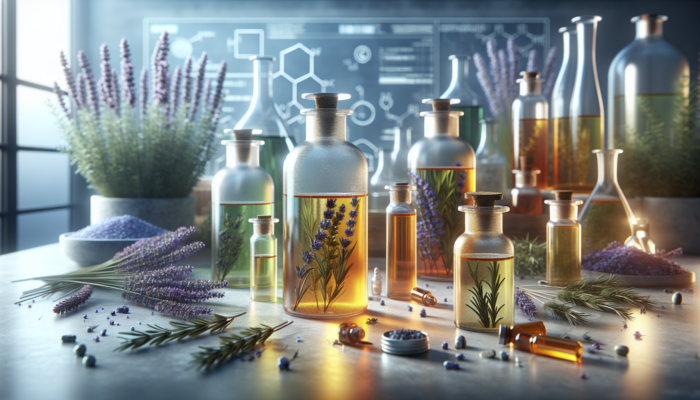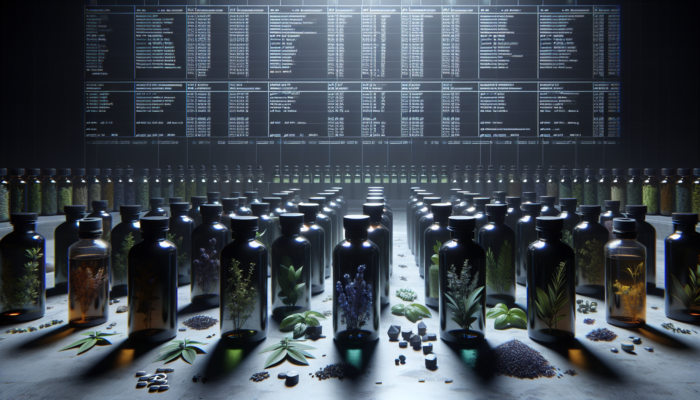Expert Techniques for Choosing the Ideal Herbs to Enhance Your Aromatherapy Journey
Embarking on your aromatic adventure into aromatherapy demands a thoughtful and informed strategy for selecting the appropriate herbs. Each herb possesses unique characteristics and therapeutic effects that can dramatically enrich your overall practice. By making educated decisions regarding the herbs you incorporate, you can significantly impact your mental and physical health, immersing yourself in the vast array of benefits that nature generously offers. This deliberate selection process not only elevates your practice but also nurtures a profound connection with the healing properties of herbal remedies, allowing for a transformative experience.
Understanding the Varied Therapeutic Properties of Different Herbs

The spectrum of therapeutic advantages that herbs can provide is extensive, and having a deep understanding of their individual properties is crucial for achieving the best results in your aromatherapy practice. For instance, the calming effects of lavender make it an exceptional choice for alleviating stress and enhancing sleep quality. Conversely, peppermint is famed for its energizing properties, which can boost focus and concentration, making it particularly beneficial during work or study sessions.
When selecting herbs, it is essential to evaluate your specific health objectives or concerns. For example, if your goal is to alleviate anxiety, consider herbs such as chamomile or lemon balm, which may offer effective relief. Alternatively, eucalyptus is well-regarded for its role in promoting respiratory health. Conducting in-depth research into the chemical constituents of these herbs, such as terpenes and flavonoids, can provide valuable insights into their effects. Numerous studies have investigated how these compounds influence physiological responses, equipping you with the knowledge necessary to tailor your herb selections to your distinct needs.
Your individual preferences also play a vital role in the selection of herbs. The aromatic characteristics of various scents can invoke memories or elicit strong emotions, making it crucial to choose fragrances that resonate with your personal tastes. Keeping a comprehensive log of your responses to different herb aromas will significantly aid in refining your future selections, ultimately enriching your aromatherapy journey and enhancing your overall experience.
Effective Strategies for Sourcing High-Quality Herbs for Your Aromatherapy Practice
Acquiring premium-quality herbs is essential for maximizing the benefits of your aromatherapy sessions. Not all herbs are created equally; their efficacy and potency can vary widely based on factors such as cultivation methods, harvesting timing, and processing techniques. Always prioritize suppliers who provide organic certification or adhere to sustainable farming practices, ensuring that you invest in the highest quality products available for your health and well-being.
Local herbalists and farmers’ markets often provide fresh herbs that tend to possess greater potency compared to dried alternatives. While online retailers offer convenience, it is vital to verify their reputation through favorable customer reviews and a history of consistent quality. Some reliable brands even share laboratory results to confirm the purity and strength of their products, allowing you to make informed decisions about your herb sources.
Furthermore, understanding the origins of your herbs is equally crucial. Herbs grown in their native environments typically exhibit richer profiles and more potent therapeutic properties. Engaging with suppliers who provide detailed information about their sourcing practices can deepen your bond with the herbs you choose, enriching your overall aromatherapy experience and enhancing the effectiveness of your sessions.
Crafting Powerful Herb Blends to Enhance Therapeutic Effects
Creating synergistic blends of herbs can significantly amplify their therapeutic benefits. Certain herbs naturally complement one another, enhancing their collective effects. For instance, a combination of eucalyptus and rosemary not only supports respiratory health but also encourages mental clarity, making this blend particularly effective in work or study environments.
When formulating your herb combinations, it is crucial to consider the harmony of aromas and therapeutic properties. A well-balanced blend might incorporate a base note, such as cedarwood, which anchors the fragrance, along with middle notes like ylang-ylang for a floral nuance, and uplifting top notes such as citrus for a refreshing lift. Experimentation is essential; begin with smaller quantities to assess their effects before committing to larger batches.
Exploring traditional herbal practices can be an excellent source of inspiration for unique blends. Many cultures have rich histories of using specific herbs in combination for enhanced healing, and leveraging this ancestral knowledge may lead to remarkable combinations tailored to your individual needs.
Core Techniques for Crafting Herbal Oils

Mastering the art of crafting herbal oils is a fundamental skill for enhancing your aromatherapy practice. This essential process enables you to extract the beneficial properties of herbs, transforming them into a potent and versatile form that can be applied in numerous ways for therapeutic benefits.
Perfecting Infusion Techniques for Herbal Oil Preparation
Developing the ability to infuse herbs into carrier oils can greatly elevate your aromatherapy practice. Two primary infusion techniques to consider are hot infusion and solar infusion. The hot infusion method entails gently heating the carrier oil with herbs to accelerate the extraction process. It is vital to monitor the temperature closely, as overheating can compromise the delicate properties of the herbs. Typically, this method requires several hours of heating, followed by straining the mixture to separate the herbs from the oil.
In contrast, solar infusion is a gentler yet more time-consuming approach. In this method, you place herbs in oil and expose them to sunlight for several weeks. The gentle warmth of the sun gradually extracts the beneficial properties of the herbs, resulting in a fragrant and potent oil. This technique not only preserves the volatile compounds but also fosters a deeper connection with nature’s rhythms, enhancing your overall experience.
Regardless of the method you opt for, maintaining a clean workspace and sterilizing your containers is crucial to prevent contamination. Utilizing dark glass bottles can further protect the quality of your infused oils by shielding them from light degradation, ensuring their potency and effectiveness over time.
Essential Knowledge of Essential Oil Extraction Techniques for Superior Blends
Acquiring knowledge about essential oil extraction methods is vital for creating powerful aromatherapy blends. Two widely used techniques—steam distillation and cold pressing—effectively extract essential oils from various herbs.
Steam distillation is the industry standard, involving the passage of steam through plant material, which causes the essential oils to evaporate and then condense into liquid form. This method preserves a significant percentage of the herb’s beneficial compounds, making it a preferred choice for many essential oils.
Cold pressing is mainly applicable to citrus oils, where oil is mechanically extracted from the fruit’s rind without heat, preserving the vibrant scent and fresh qualities of the fruit. This process results in lively additions to any aromatherapy blend, enhancing its effectiveness.
Understanding these extraction processes can greatly enhance your knowledge of the oils you incorporate, allowing you to make more informed choices based on the desired effects and applications of your blends.
Best Practices for Storing and Preserving Your Herbal Oils

Proper storage and preservation of your herbal oils are crucial for maintaining their potency and extending their shelf life. While essential oils are powerful, they can degrade when exposed to light, heat, or air. Always store your oils in dark glass bottles to protect them from light, and keep them in a cool, dark environment to preserve their quality.
Regularly inspecting your oils for any changes in color, scent, or consistency is essential, as these can indicate deterioration. If you notice any alterations, it may be time to dispose of the oil. Labeling your oils with the preparation date can assist you in tracking their freshness and potency over time, ensuring you get the most out of your investments.
In addition to selecting appropriate containers, consider incorporating antioxidants, such as Vitamin E oil, into your mixtures. This addition can help prevent oxidation, prolong the lifespan of the oils, and ensure you continue to enjoy the full benefits of your aromatherapy sessions.
Choosing the Most Suitable Herbs for Oil Infusion
Choosing the right herbs for oil infusion is paramount for achieving optimal results. Certain herbs possess natural oil content and therapeutic properties that make them particularly suitable for extraction. For instance, herbs like calendula and hypericum are excellent choices for skincare applications, offering soothing and healing properties that nourish and rejuvenate the skin.
When contemplating your herb selections, reflect on their aromatic profiles and how they will harmonize with your chosen carrier oils. Robust herbs like rosemary or thyme may work best with lighter carrier oils, such as grapeseed or sweet almond oil, allowing their active constituents to shine without being overshadowed by heavier oils.
Experimenting with various herbs and deepening your understanding of their properties will empower you to create herbal oils that cater to your specific needs, enriching your aromatherapy experience and enhancing its therapeutic effects.
Advanced Aromatherapy Techniques for Optimal Therapeutic Benefits
Once you have successfully prepared your herbal oils, employing effective aromatherapy techniques is crucial for harnessing their full potential and enhancing your overall experience.
Enhancing Your Environment Using Diffusers for a Soothing Aromatic Atmosphere
Utilizing a diffuser is one of the most popular and effective methods for dispersing the delightful aromas of herbal oils throughout a space. Diffusers break the oils into smaller particles, allowing them to permeate the air and create a fragrant environment that uplifts moods or encourages relaxation.
When operating a diffuser, take into account the size of the room and the potency of the oil. A few drops may suffice for smaller spaces, while larger areas might require a more generous application to achieve the desired scent intensity. Blending different herbal oils can yield unique scent profiles tailored to your mood or the ambiance you wish to foster.
Regular maintenance of your diffuser is essential for ensuring its longevity and preserving the purity of the scents. Residual oil can affect the aroma of future blends, making it vital to adhere to the manufacturer’s cleaning guidelines diligently.
Topical Application Techniques for Targeted Therapeutic Relief
Applying herbal oils topically can deliver focused relief for various ailments, from muscle soreness to skin irritations. However, safety is of utmost importance. Always dilute essential oils in a carrier oil before applying them to the skin. A general guideline is to maintain a dilution ratio of 1-2% for adults, with even lower concentrations recommended for children or individuals with sensitive skin.
When applying herbal oils topically, identify specific areas of concern. For instance, if you are experiencing tension headaches, consider using a diluted blend of peppermint oil on your temples. The cooling sensation can provide immediate relief while the aroma promotes relaxation and calmness.
Always conduct a patch test to identify potential allergic reactions before applying a new blend to larger skin areas. Monitoring your skin’s response can safeguard against adverse effects and ensure a positive experience with your aromatherapy practice.
Utilizing Inhalation Methods for Immediate Aromatic Benefits
Inhalation techniques present another effective means to experience the benefits of herbal aromas. Steam inhalation is a commonly employed method for addressing respiratory concerns. Adding a few drops of eucalyptus or tea tree oil to a bowl of hot water can create a soothing steam inhalation session. The steam helps to clear nasal passages, allowing for deep inhalation of the beneficial properties of the oils.
Another effective approach is direct inhalation, where you place a drop of essential oil on a cotton ball or tissue and inhale the aroma deeply. This method is particularly useful for quick relief from stress or anxiety. However, moderation is essential, as excessive inhalation can overwhelm the senses.
Creating a personal inhaler can also be advantageous. Small, portable inhalers filled with cotton and a few drops of essential oil can be carried anywhere, enabling you to access your calming or invigorating scents whenever needed.
Creating Tailored Blends for Unique Aromatherapy Experiences
Designing custom blends allows you to personalize your aromatherapy experience to address your specific needs and preferences. A nuanced understanding of scent and herb properties can elevate your practice to new heights.
Achieving a Harmonious Aroma in Your Custom Blends
Crafting well-balanced blends requires a keen understanding of how to harmonize the scents of different herbs. Begin by selecting a base note, which is generally heavier and more grounding, such as vetiver or patchouli. This foundational note anchors the other elements of your blend, creating a cohesive aromatic profile.
Next, incorporate middle notes that provide the heart of your blend. Consider floral herbs like geranium or spicy notes such as cardamom to introduce complexity. Finally, add top notes like citrus or mint, which deliver an immediate burst of fragrance. The interplay of these notes creates a rich, full-bodied aroma that captivates the senses and enhances therapeutic effects.
Take the time to experiment with different combinations, adjusting the ratios to discover the right balance that resonates with you. Keeping a detailed record of your blends can assist in refining your skills and guiding future creations, ensuring that you cultivate a unique style throughout your aromatherapy journey.
Addressing Specific Health Concerns with Your Tailored Blends
Custom blends can be formulated specifically with particular health issues in mind. For instance, consider blending calming herbs like lavender and chamomile with grounding oils such as frankincense to alleviate feelings of anxiety and promote relaxation. Understanding the unique properties of each herb and their interactions is crucial for creating a blend that effectively supports relaxation and well-being.
Moreover, crafting blends to enhance immune support may include immune-boosting herbs like thyme and <a href="https://mcrtherapies.co.uk/herbal-tea-recipes-easy-and-refreshing-for-beginners/">lemon</a>, combined with uplifting scents such as bergamot. Tailoring the composition according to your needs and remaining open to modifying the blend over time as you learn from your experiences can significantly enhance your overall wellness and therapeutic outcomes.
By aligning your custom blends with your wellness objectives, you can optimize the benefits of your aromatherapy sessions, ensuring they are both enjoyable and profoundly advantageous for your holistic health.
Modifying Potency for Desired Therapeutic Effects
The potency of your custom blends can dramatically influence their effectiveness. Learning how to adjust the concentration of herbs is essential for achieving the desired therapeutic outcomes. Start by experimenting with different ratios, gradually increasing or decreasing the amount of essential oil in relation to the carrier oil.
It is equally crucial to consider the sensitivities of individuals using the blends. For instance, children or people with sensitive skin may require lower concentrations to ensure safety. Always prioritize safety and remain adaptable in your approach, making adjustments based on feedback from your body or the experiences of others using your blends.
Keep in mind that potency also affects scent intensity. A concentrated blend may produce a strong aroma, while a more diluted mixture can yield a subtler scent. Engaging in this exploration will help you develop a nuanced understanding of how to create the most effective blends tailored to your unique needs and preferences.
Crucial Safety Guidelines for Aromatherapy Practices
Safety is paramount when incorporating herbs into your aromatherapy practice. Recognizing potential risks and understanding how to mitigate them can enhance your experience, ensuring that you fully benefit from the practice without adverse effects.
Avoiding Allergic Reactions to Herbal Ingredients
Allergic reactions to certain herbs can range from mild irritation to severe responses. It is vital to research each herb before use and remain aware of any known allergies you may have. Conducting a patch test is a wise precaution; dilute the oil and apply it to a small area of skin, observing for any adverse reactions over a 24-hour period.
If you plan to use essential oils in a group setting, such as with family or friends, it is prudent to inquire about any allergies among participants. This knowledge helps create a safe and enjoyable environment for everyone involved, ensuring that aromatherapy remains beneficial for all.
Furthermore, consider using high-quality, ethically sourced herbs. Contaminants or adulterants found in low-quality products can provoke allergic responses or other health issues, making it crucial to prioritize reputable suppliers for your safety and well-being.
Understanding Proper Dilution Techniques for Safety
Correctly diluting essential oils is essential in preventing skin irritation or adverse reactions. A general guideline is to maintain a dilution ratio of 1% for topical applications, which translates to approximately one drop of essential oil for every teaspoon of carrier oil. For sensitive areas, such as the face, consider diluting even further for safety.
Always adhere to established dilution guidelines, especially when working with potent oils. Numerous online resources and books provide detailed dilution charts for various oils, ensuring that you can safely maximize their benefits while minimizing risks.
Educating yourself on the specifics of each essential oil is also essential. Some oils are inherently more potent than others and may require greater dilution. Understanding each oil’s properties and potential effects can safeguard you against unwanted side effects and enhance your overall experience.
Recognizing Contraindications for Safe Herb Usage
Certain health conditions can influence your choice of herbs in aromatherapy. For instance, pregnant women are often advised to avoid specific essential oils, such as sage or rosemary, due to their potential to trigger contractions. Individuals with specific medical conditions, such as epilepsy or hypertension, should consult healthcare professionals before using certain herbs.
Awareness of contraindications helps establish a safe practice that respects both your well-being and that of others. A qualified aromatherapist or healthcare provider can offer tailored advice based on your unique circumstances and needs, ensuring that you can safely explore the benefits of using herbs in aromatherapy.
Always maintain open communication with your healthcare provider regarding your aromatherapy practices. This transparency ensures that you can safely enjoy the benefits of using herbs in aromatherapy while placing your health and safety as a priority.
Enhancing Your Aromatherapy Practice for a Meaningful Connection
Improving your practice can significantly enrich your experience and broaden your knowledge as you delve deeper into the world of herbs and aromatherapy.
Utilizing a Journal to Document Your Aromatherapy Experiences
Keeping a journal serves as an invaluable tool for tracking your experiences in herbal aromatherapy. Documenting your blends and noting their specific effects on your mood or physical well-being can yield significant insights over time, helping to refine your practice and enhance your results.
Include details such as the quantities of each herb used, the preparation methods, and your overall impressions. This record can act as a reference for future blending and highlight patterns in how specific scents influence your emotional or physical health, ultimately guiding your journey.
Your journal can also become a creative outlet. Sketching ideas for new blends or noting inspirational moments can foster a deeper connection to your practice, transforming your aromatherapy journey into a rich tapestry of personal growth and exploration.
Continuing Your Education in Herbal Aromatherapy for Enhanced Mastery
Staying informed about the latest research and techniques in herbal aromatherapy is crucial for ensuring safety and efficacy. Consider participating in workshops or enrolling in courses offered by reputable organizations. Online platforms also provide valuable information, ranging from instructional videos to in-depth articles authored by experienced practitioners.
Reading books dedicated to herbal healing and aromatherapy can deepen your understanding. Many publications offer insights into the historical uses of herbs alongside contemporary applications, providing a well-rounded view of the field that can be invaluable for your practice.
Networking with fellow enthusiasts or professionals can also be beneficial. Engaging in discussions can spark new ideas and perspectives, enriching your practice and broadening your horizons as you navigate the world of aromatherapy.
Sharing Your Knowledge and Experiences to Inspire Others
As you gain experience using herbs in aromatherapy, consider sharing your knowledge with others. Conducting workshops or writing articles can help others benefit from your expertise while deepening your understanding of the material. Teaching others requires a thorough grasp of the subject, which can further solidify your knowledge and skills.
Social media platforms provide excellent opportunities to connect with like-minded individuals. Engaging in discussions or sharing personal experiences can create a supportive community focused on holistic health and well-being.
Moreover, your insights may inspire someone else to embark on their journey into herbal aromatherapy, creating a ripple effect of knowledge and healing throughout your community.
Experimenting with Innovative Approaches in Aromatherapy
Exploring new methods and applications in herbal aromatherapy can significantly expand your skill set. Don’t hesitate to try different blending techniques, infusion methods, or even unconventional applications of herbs. Attending workshops or following online tutorials can introduce you to innovative practices that you may not have considered previously.
Consider integrating other wellness practices like meditation or yoga into your aromatherapy sessions. Combining these techniques can significantly enhance your overall experience, promoting deeper relaxation or mindfulness and enriching your practice.
Be open to documenting these new explorations in your journal, noting any changes or improvements in your well-being. This reflection can help you identify what resonates most effectively with you and inform your future practices, ensuring a continually evolving journey in aromatherapy.
Seeking Professional Guidance for Mastering Aromatherapy
Consulting with experienced practitioners can provide invaluable insights for refining your aromatherapy techniques. Whether through formal education or informal mentorship, engaging with knowledgeable individuals can significantly enhance your understanding of the subject and elevate your practice.
Utilize resources such as online forums or local herbalist groups to connect with professionals in the field. Their wealth of experience can help you navigate challenges you may face in your practice and provide clarity on complex topics that require deeper exploration.
Always approach mentorship with an open mind, ready to absorb new information and perspectives. This willingness to learn will accelerate your growth in herbal aromatherapy, ensuring a rewarding and fulfilling practice that brings you joy and healing.
Common Questions About Herbs and Aromatherapy
What herbs are best suited for beginners in aromatherapy?
Common herbs such as lavender, peppermint, and chamomile are excellent choices for newcomers. These herbs are versatile, widely available, and have well-documented benefits, making them ideal for those starting their aromatherapy journey.
Can I use dried herbs for infusion purposes?
Dried herbs, which often contain concentrated properties, can indeed be used for infusion. To maintain maximum potency in your blends, ensure they are stored correctly and sourced from reputable suppliers that prioritize quality.
How can I determine if I am allergic to a specific herb?
Conduct a patch test by applying a diluted oil to a small area of skin. Wait 24 hours to see if any irritation occurs before using it more extensively on larger skin areas, ensuring your safety.
What distinguishes essential oil from herbal oil?
Essential oils are concentrated extracts derived from plants, while herbal oils are typically infused oils made by steeping herbs in a carrier oil to extract their beneficial properties.
What methods can I employ to enhance the potency of my herbal blends?
Experiment with varying ratios of essential oils to carrier oils and consider incorporating antioxidant agents like Vitamin E to preserve potency. Always monitor reactions to adjust accordingly for optimal results.
Is it safe to apply essential oils directly to my skin?
Essential oils should never be applied directly without proper dilution, as they can cause skin irritation. Always dilute essential oils in a carrier oil before applying them to the skin to ensure safety and comfort.
What benefits do herbal oils provide during massage sessions?
Herbal oils can significantly enhance the massage experience by delivering additional therapeutic benefits, such as relieving muscle tension, promoting relaxation, and improving circulation throughout the body.
What is the typical shelf life of herbal oils?
When stored correctly in dark glass containers and kept in a cool, dark environment, herbal oils can last up to a year. Always check for changes in scent or color as indicators of quality and freshness.
Can I use herbal oils during pregnancy?
Some herbal oils are contraindicated during pregnancy, while others may be safe. Always consult with a healthcare provider before using any essential oils during this time to ensure safety for both you and your baby.
How do I select the best carrier oil for my needs?
The choice of carrier oil should depend on your skin type and the desired effects. For example, jojoba oil is excellent for all skin types, while sweet almond oil is particularly nourishing for dry skin. Researching the properties of various carrier oils can help you find the best fit for your unique needs.
Connect with us on Facebook!
The Article: How to Use Herbs in Aromatherapy for Wellness appeared first on https://mcrtherapies.co.uk
The Article Herbs in Aromatherapy: A Guide to Wellness Benefits appeared first on https://mcrtherapies.com
The Article Aromatherapy Herbs: Your Guide to Wellness Benefits Was Found On https://limitsofstrategy.com

